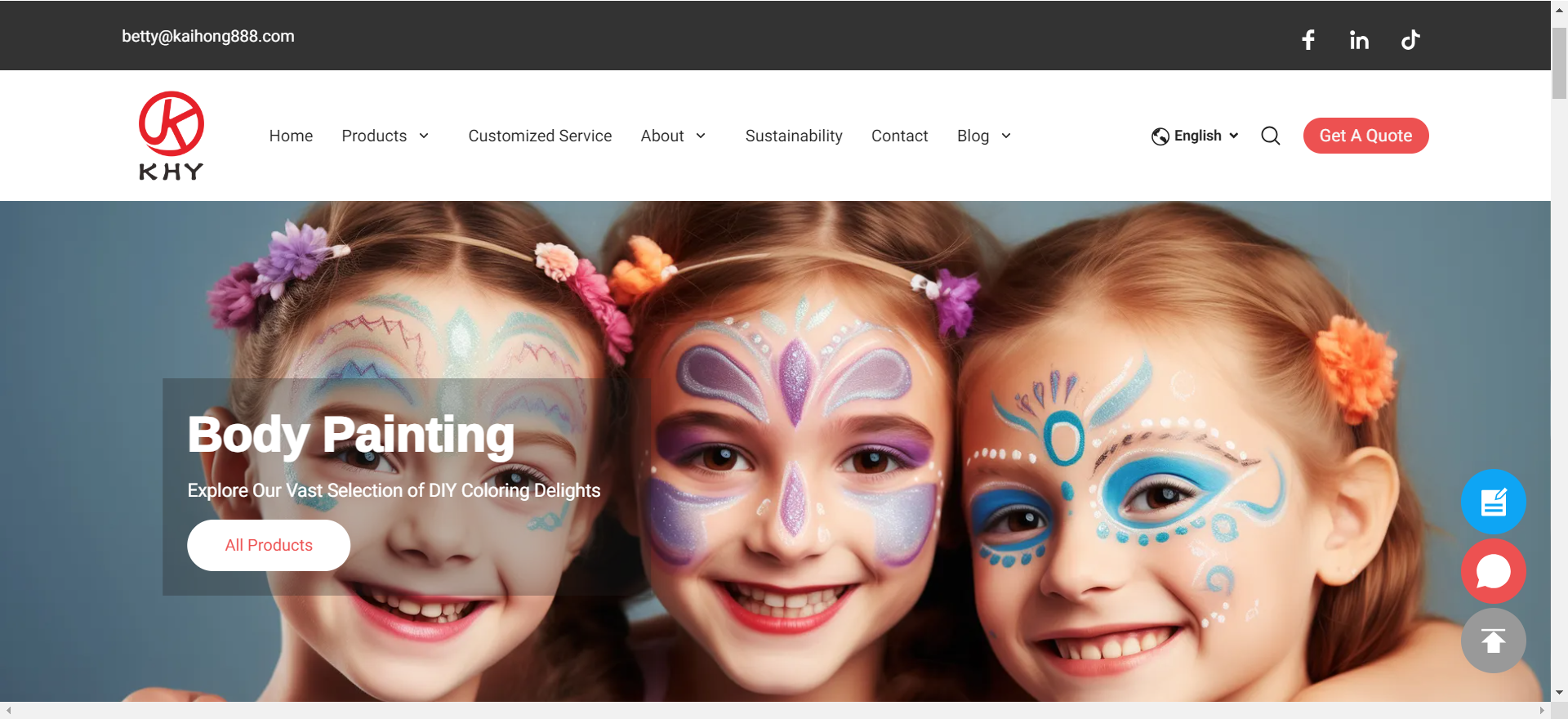betty@kaihong888.com

Get A Quote
Is Acrylic Paint Safe for Face Painting?
Face painting has become a beloved activity for children’s parties, festivals, and even artistic performances. It’s a fun way to transform ordinary moments into extraordinary ones, and it brings smiles to the faces of both children and adults. However, with the variety of paints available on the market, a common question arises: "Is acrylic paint safe for face painting?" This blog aims to answer that question comprehensively, addressing concerns about safety, alternatives, and best practices in face painting.
Understanding Acrylic Paint
Acrylic paint is a versatile medium known for its vibrant colors and quick-drying properties. It is water-based, which means it can be diluted with water and cleaned up easily. Artists and hobbyists appreciate acrylic paint for its flexibility, as it can be used on various surfaces including canvas, wood, and metal. But when it comes to face painting, the suitability of acrylic paint comes into question.
What Is Acrylic Paint Made Of?
Acrylic paint consists of pigment suspended in an acrylic polymer emulsion. It is known for its durability and flexibility when dry, which makes it ideal for long-lasting art on more permanent surfaces. The ingredients in acrylic paint include:
- Pigments: These provide the color and can be natural or synthetic.
- Binders: Acrylic polymer that helps the pigment adhere to surfaces.
- Solvents: Water or other solvents that keep the paint in liquid form until it dries.
- Additives: Chemicals that modify properties like drying time, texture, and finish.
While these ingredients are generally safe for use on various art projects, their safety on human skin is another matter.
Is Acrylic Paint Safe for Face Painting?
The primary concern with using acrylic paint for face painting revolves around skin sensitivity and potential health risks. Here are some key points to consider:
Skin Sensitivity and Allergic Reactions
Acrylic paint is not formulated for use on skin. The pigments and additives, while safe for use on canvas or wood, can cause allergic reactions or skin irritation. This is particularly concerning for individuals with sensitive skin, children, and those with pre-existing skin conditions. Common symptoms of an allergic reaction to acrylic paint on the skin include redness, itching, and rash.
Toxicity and Harmful Ingredients
Some acrylic paints contain toxic ingredients such as heavy metals (e.g., cadmium, cobalt) and formaldehyde. These substances are safe in small quantities when used on non-porous surfaces but can be harmful when applied to the skin. Even acrylic paints labeled "non-toxic" are not necessarily safe for face painting, as this designation typically means the paint is safe to use in a well-ventilated area and not ingested.
Removal Difficulty
Acrylic paint adheres strongly to surfaces, including skin, making it difficult to remove. This can lead to excessive scrubbing, which can irritate the skin further. Additionally, solvents needed to remove stubborn acrylic paint residues can be harsh on the skin.
Safe Alternatives for Face Painting
Given the risks associated with using acrylic paint for face painting, it’s essential to explore safer alternatives. Here are some options designed specifically for use on skin:
Professional Face Paints
Professional face paints are formulated specifically for use on the skin. They are typically water-based and contain safe pigments and binders that are non-toxic and hypoallergenic. Brands like KHY diy paint offers a range of colors that are safe for both children and adults. These paints are easy to apply, comfortable to wear, and wash off easily with soap and water.
Natural Face Paints
For those looking for even safer options, natural face paints made from organic ingredients are available. These paints often use plant-based pigments and natural binders, ensuring they are gentle on the skin. While they may not offer the same vibrant colors as synthetic paints, they are a great choice for those with highly sensitive skin or a preference for eco-friendly products.
Makeup Products
Another alternative is to use cosmetic-grade makeup products like eyeshadows, lipsticks, and eyeliners. These products are designed for use on the skin and are subjected to rigorous safety testing. They come in a wide variety of colors and can achieve similar effects to face paint.
Best Practices for Safe Face Painting
To ensure a fun and safe face painting experience, follow these best practices:
Patch Test
Before applying any paint or makeup to a large area of the face, perform a patch test. Apply a small amount of the product to a discreet area of the skin and wait 24 hours to check for any adverse reactions.
Use Clean Brushes and Sponges
Always use clean brushes and sponges to apply face paint. Dirty tools can harbor bacteria, leading to skin infections.
Avoid Sensitive Areas
Avoid painting near the eyes, mouth, and any cuts or abrasions. These areas are more susceptible to irritation and infection.
Monitor for Reactions
Keep an eye on the person being painted, especially children, for any signs of discomfort or allergic reactions. If any symptoms occur, remove the paint immediately and rinse the area with water.
Choose the Right Products
Opt for face paints that are specifically labeled as safe for skin use. Check for certifications or approvals from health and safety organizations. For instance, the Khy Face Paint Kit is an excellent choice. This kit is designed specifically for face painting, ensuring it is safe for skin use. It is hypoallergenic, non-toxic, and easy to remove with soap and water. Additionally, it comes with a variety of vibrant colors and clean brushes, making it a convenient and reliable option for all your face painting needs.
Conclusion
While acrylic paint is an excellent medium for many art projects, it is not suitable for face painting. The potential for skin irritation, allergic reactions, and exposure to harmful chemicals makes it a risky choice. Instead, use professional face paints, natural face paints, or cosmetic-grade makeup products that are designed to be safe for the skin. By following best practices and choosing the right products, you can ensure a safe and enjoyable face painting experience for all.
For those looking to engage in face painting, whether as a hobby or professionally, KHY's comprehensive DIY body painting supplies offer a fantastic solution. KHY provides a range of face paints specifically formulated to be safe for the skin, ensuring vibrant colors and ease of use. With KHY, you can unleash your creativity with confidence, knowing that you are using products designed with your safety and satisfaction in mind. Embrace the vibrant world of face painting with KHY and let your creativity soar!

